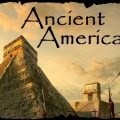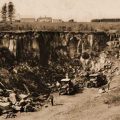While the region of North America known today as Montana entered into written Euro-American histories in the early nineteenth century with the Corps of Discovery led by Meriwether Lewis and William Clark, Indian people had been living in the area for many millennia. Archaeologists often refer to the era prior to 6000 BCE as Paleo-Indian. This appears to have been a time when the people specialized in the hunting of big game.
With regard to the archaeological record for Montana, In his Ph.D. dissertation on the MacHaffie site for Columbia University, Richard Forbis reports: “The raw material for archeology in Montana consists largely of campsites (most often entirely lithic in content), workshops, scattered hearths and tipi rings, bison kills and traps, trailside offertory stone heaps, burials, and pictographs. Chipped stone work, often found out of meaningful association, is common while ground stone is rare.”
Briefly described below are a few of the ancient sites which have been uncovered by archaeologists.
Anzick Rockshelter:
By about 9550 BCE, Indian people were using the Anzick rockshelter (24PA506) near present-day Gardiner for burials. Interred with the burials were finely made bone projectile points as well as both finished and unfinished Clovis-like stone points. Archaeologists uncovered more than 100 stone artifacts and a number of bone tools in this collapsed rock shelter. The artifacts had been covered with a heavy coating of red ochre.
Archaeologists also found human remains at the site. Archaeologists Dennis Stanford and Bruce Bradley, in their book Across Atlantic Ice: The Origins of America’s Clovis Culture, write: “The remains of a toddler consisted primarily of skull fragments, and the artifacts were all stained with red ochre. The other individual has been shown to be unassociated with the Clovis materials.”
In his book Prehistory of the Americas, Stuart Fiedel writes: “The application of a blood-colored pigment to the corpse may have been a symbolic restoration of life.”
Since the children buried here were accompanied by stone tools, it is assumed that these items were gifts rather than items the deceased had used while living. Archaeologist Douglas MacDonald, in his book Montana Before History: 11,000 Years of Hunter-Gatherers in the Rockies and Plains, writes: “It seems fairly clear that they were placed with the infant as part of a ritual or ceremony.” The stones had come from a variety of different locations.
Archaeologists Dennis Stanford and Bruce Bradley report: “Eleven bone rods were among the artifacts collected from the disturbed deposits of the site: two complete rods, four fragments with beveled ends, and five midsections.”
DNA from the remains show that they are related to most modern American Indians.
Mill Iron Site:
While Clovis points are both well-known today and highly distinctive, there were other lithic technologies being used more than 11,000 years ago. Indian people at the Mill Iron Site (24CT30) were using well-made, bifacial projectile points with a concave base which were neither fluted nor made in a Clovis-style. Archaeologists have classified these large lanceolate projectile points as Goshen. Goshen culture is often associated with bison hunting.
While contemporaneous with Clovis, Goshen projectile points are not fluted or basally thinned. The Mill Iron site contained 1,709 stone tools. Archaeologist Douglas MacDonald reports: “Most of the raw stone at the site was obtained locally.”
The Indian people at the site killed at least 30 bison, all adults and mostly cows, at a spring or early summer event. Archaeologist Douglas MacDonald writes: “Low-value animal parts dominate at the kill site, suggesting that the hunters took the best parts of the animals with them when they left.”
MacHaffie Site:
By 9000 BCE, Indians using Folsom technology were using the MacHaffie Site. Their lithic tool kit included points (including the classic Folsom style), knives, scrapers (several kinds), gouges, and choppers. In his Ph.D. dissertation on the MacHaffie site for Columbia University, Richard Forbis reports: “The absence of grinding stones at the MacHaffie site indicates a lack of concern with seed gathering and seems to indicate that the early hunters at the site gathered nuts, roots, and berries that did not require grinding to make them palatable.” The Indians at this site were hunting deer.
By 4900 BCE, Indian people using Scottsbluff technology were using the MacHaffie Site. Their lithic toolkit included points, knives (including a stemmed knife), scrapers, choppers. Richard Forbis reports: “The MacHaffie site yielded a wide range of Scottsbluff artifacts. Like Folsom, Scottsbluff sites may share little more in common than the distinctive projectile points from which their name is derived.”
Some other sites:
False Cougar Cave: Indian people occupied the False Cougar Cave in the Pryor Mountains by about 12,600 BCE. DNA analysis of a hair from the site is associated with haplogroup X.
Lindsay Site: The Lindsay site (24DW501) was a mammoth kill site which was occupied about 11,000 BCE.
Indian Creek Site: Indian people occupied the Indian Creek site (24BW626) prior to 9000 BCE. This site represents a Folsom adaption to a higher elevation.
Baron Gulch Site: By 7400 BCE, Indian people at the Barton Gulch site (21MA171) were gathering and processing a variety of food plants, including slimleaf goosefoot (Chenopodium leptophllum) and prickly pear cactus (Opuntia polyacantha). They were using roasting pits to process these foods.
Pictograph Caves: By 7100 BCE, Indian people were using Pictograph Caves near present-day Billings.
Myers-Hindman Site: By 7000 BCE, Indian people were occupying the Myers-Hindman site near Livingston. They were hunting pronghorn, deer, elk, and sheep. They also had dogs.
Dawson County: By 7000 BCE, Indian people using Goshen projectile points were occupying site 24DW272 in Dawson County.
Some Complexes and Tool Traditions:
A complex is simply a group of tools and artifacts which are associated together at a number of different sites. Archaeologists use complexes for showing the relationships between different sites. A complex is also a chronological unit and thus can be used for the initial dating of a site.
Goatfell Complex: The Goatfell Complex spread throughout southeastern British Columbia and northwestern Montana by 9000 BCE. In her M.A. Thesis for the University of Montana, Mary Collins reports: “It was defined by a preference for black metamorphosed siltstone, large stemmed lanceolate and leaf shaped spear points, and large flake blanks and tools. Biface manufacture was characterized by the removal of large expanding flakes with acute angled, faceted striking platforms.”
Hell Gap Complex: The cultural tradition which archaeologists call the Hell Gap Complex moved into the Northern Plains about 7600 BCE. Hell Gap people were big game hunters with a primary emphasis on bison. The sites tend to be short-term campsites.
Pryor Stemmed Projectile Point: By 6300 BCE, Indian people were using Pryor Stemmed Projectile Points in the Pryor and Bighorn mountain area as well as in parts of central Wyoming.
Cody Complex: The Cody Complex, which included an assemblage of projectile points, scrapers, gravers, wedges, choppers, hammer stones, and bone tools, was associated with bison kill and processing sites. This complex first appears about 8000 BCE. By 7400 BCE, Indian people using Cody Complex tools were using the Mammoth Meadow site for the production of stone tools. They were killing bison as well as other mammals.



Leave a Reply